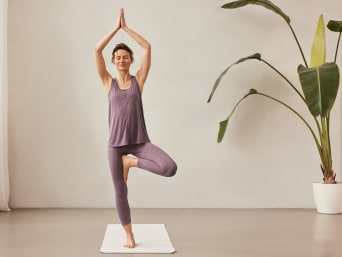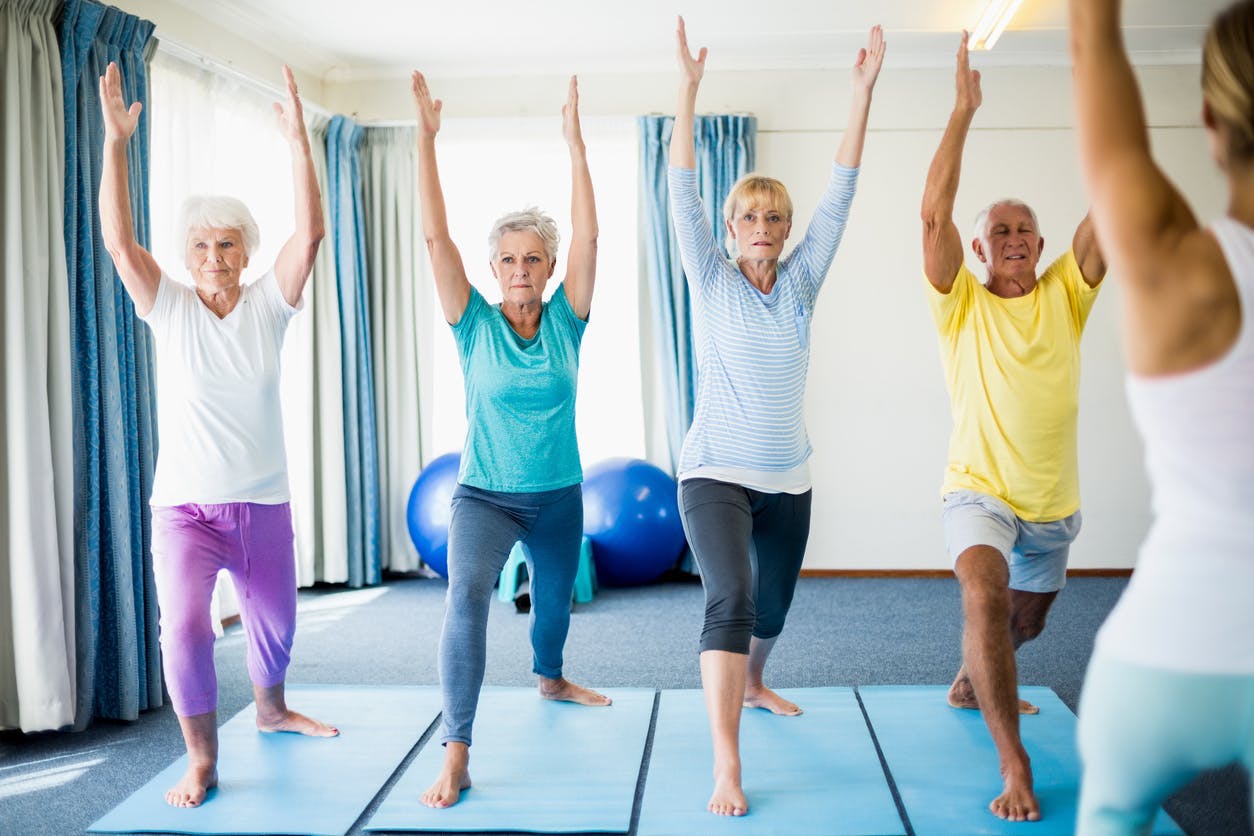
Yoga leg poses can strengthen your legs. Start by lying down on your mat, with your feet slightly bent. The next step is to lift your left knee up and extend your right leg over your left hip. Now, extend your right leg straight up and over your chest. Next, use your left hand to grab your right knee and attach it to the mat. You can do the same with the other leg. Also, bend the left leg towards your chest.
The second yoga leg pose is called legs-up-the-wall. This posture is known to help lower blood pressure and relieve stress. For this yoga pose, lower yourself to the floor and move your legs closer to it. Place your head on the ground. Continue to hold the pose for a few minutes until the tingling stops. Return to the pose once you feel no tingling. This poses are great for the thighs and hamstrings.

The legs-up-the wall pose can be done for many reasons. Not only does it help to improve digestion, it also helps strengthen your arteriovenous system. It also helps to keep your body light-weight and flexible by pumping blood toward your legs and hips. It can help with menstrual problems, too. It's even beneficial for aging. You can do this yoga leg pose by finding a spot near a wall. Then, you will need to adjust your body so that it is in the right position. If necessary, you can also place a blanket underneath your back.
The adductor stretching stretches your inner thighs. Start by bending your left knee slightly, and then lift your butt up. Do this for about 30 seconds and then repeat on the other side. Your inner thighs will be stretched with this yoga leg stretch. You can bring your head to the ground by taking deep, slow breaths. To get a better feeling of the pose, you can hold it for several minutes.
Yoga leg stretch can reduce lower leg swelling and also provide therapeutic benefits for your lower back, feet, and lower back. This is a great exercise to help you recover from a hard workout or relax your legs. These yoga poses offer many other benefits than the physical. They are good for anxiety, premenstrual syndrome, and fatigue. These exercises can relieve a range of symptoms. Yoga can improve flexibility and mobility in the legs.

Yoga leg stretch can be a great way to relieve stress and strengthen your legs. To tone the lower body, yoga leg stretch is a great way to tone it. Try the wall pose to increase your flexibility. You'll feel the difference when you start doing this stretch. You'll have a more sculpted leg in no time. This is also a great way to increase circulation. In addition to your legs, you'll look better overall with a strong lower body.
FAQ
Why should we have a healthy lifestyle to begin with?
Healthy lifestyles lead to happier and longer lives. Regular exercise, healthy eating habits, healthy sleep habits and stress management can all help prevent strokes, heart disease, diabetes, and cancer.
A healthy lifestyle helps us cope better when we are faced with everyday stresses. Healthy living will boost self-confidence and make you look and feel younger.
How can I lower my blood pressure
Find out the causes of high blood pressure first. You must then take steps towards reducing the problem. This could include eating less salt, losing weight if necessary, taking medication, etc.
Also, make sure to get enough exercise. Walking can be a good alternative to regular exercise if time is tight.
You should join a gym if you are unhappy with your exercise routine. It's likely that you will want to join a gym with other people who are working towards the same goals as you. It's easier for you to exercise if you know that someone will be watching you at the club.
Is it possible to have a weak immune system due to being cold?
There are two types of people in the world: those who love winter and those that hate it. You might wonder why you feel so miserable in the cold, no matter how much you love or hate winter.
The fact is that our bodies are designed for warmth and function best. We evolved to thrive in hot environments because of the abundance of food resources.
However, our environment is quite different than that of our ancestors. We spend much more time indoors, often exposed to extreme temperatures (cold and heat), and we eat foods that are processed rather than fresh.
As a result, our bodies aren't used to such extremes anymore. That means that when we do venture outdoors, we're left feeling tired, sluggish, and even sick.
There are many ways to avoid these side effects. The best way to avoid these problems is to ensure that your body stays hydrated throughout the day. Hydration is key to keeping your body well hydrated, flushing out toxins and keeping your system healthy.
You must also ensure that you are eating healthy foods. The best way to maintain your body's optimal temperature is by eating nutritious food. This is especially helpful for people who spend a lot of time indoors.
Finally, consider taking a few minutes each morning to meditate. Meditation is a great way to relax your body and mind. It makes it easier for you to cope with stress and illness.
Is being cold bad for your immune system?
Cold can make you less immune to infection because your body makes fewer white blood cells, which are essential for fighting infections. Cold can also make you feel better as your body releases endorphins to your brain, which reduce pain.
What are the 10 most delicious foods?
These are 10 of the best foods to eat.
-
Avocados
-
Berries
-
Broccoli
-
Cauliflower
-
Eggs
-
Fish
-
Grains
-
Nuts
-
Oats
-
Salmon
Statistics
- WHO recommends consuming less than 5% of total energy intake for additional health benefits. (who.int)
- Extra virgin olive oil may benefit heart health, as people who consume it have a lower risk for dying from heart attacks and strokes according to some evidence (57Trusted Source (healthline.com)
- According to the Physical Activity Guidelines for Americans, we should strive for at least 150 minutes of moderate intensity activity each week (54Trusted Source Smoking, harmful use of drugs, and alcohol abuse can all seriously negatively affect your health. (healthline.com)
- According to the 2020 Dietary Guidelines for Americans, a balanced diet high in fruits and vegetables, lean protein, low-fat dairy and whole grains is needed for optimal energy. (mayoclinichealthsystem.org)
External Links
How To
What does the "vitamins” word mean?
Vitamins can be described as organic compounds found in food. Vitamins are necessary for us to absorb nutrients in the foods we consume. Vitamins cannot be produced by the body. They must be acquired from food.
There are two types vitamins: water soluble or fat soluble. Water-soluble vitamins dissolve quickly in water. Vitamin C,B1(thiamine), B2 (2riboflavin), and B3 (3niacin), as well as vitamin C,B1, B2 (riboflavin), and B3 (niacin), vitamin B6 (pyridoxine), vitamin folic acid (biotin), pantothenic, and choline are examples. Fat soluble vitamins are stored in the liver and fatty tissue. You can find vitamin D, E K, A, beta carotene, and other fat-soluble vitamins.
Vitamins are classified according to their biological activity. There are eight major vitamin groups:
-
A - vital for healthy growth.
-
C is important for nerve function and energy production.
-
D – Essential for healthy teeth, bones and joints
-
E is required for good vision and reproduction.
-
K - essential for healthy muscles, nerves, and bones.
-
P – vital for building strong bones.
-
Q – aids digestion of iron and iron absorption
-
R - necessary for making red blood cells.
The recommended daily allowance (RDA) of vitamins varies depending on age, gender, and physical condition. The U.S. Food and Drug Administration sets RDA values.
For example, the RDA for vitamin A is 400 micrograms per dayfor adults 19 years or older. However, pregnant women need 600 micrograms per day because it is important for fetal development. Children ages 1-8 require 900 micrograms per day. For infants younger than one year, 700 micrograms are required daily. However, this number drops to 500 micrograms each day for children aged 9-12 months.
Children aged 1-18 years need 800 micrograms daily, while children overweight require 1000 micrograms per days. Children who are severely obese or underweight will need 1200 micrograms each day.
Children aged 4-8 years old who have been diagnosed as having anemia require 2200 micrograms of vitamin C per day.
2000 micrograms is the minimum daily intake for adults over 50 years old to maintain good health. Women who are pregnant or breastfeeding need 3000 micrograms per day due to increased nutrient requirements.
Adults over 70 require 1500 micrograms each day, since they lose around 10% of their muscle mass every decade.
Women who are pregnant, nursing or breastfeeding need more than the RDA. Pregnant women require 4000 micrograms daily during pregnancy, and 2500 micrograms every day after birth. Breastfeeding mothers require 5000 micrograms daily when breast milk production is occurring.